Performance Evaluation and Comparison of Modified Spectral Mixture Analysis Method for Different Images of Landsat Series Satellites
Abstract
1. Introduction
2. Materials and Methods
2.1. Research Scheme
2.2. Data
2.3. Methods
2.3.1. DELSMA Model
2.3.2. Accuracy Assessment
2.4. Study Area
3. Results
3.1. Model Verification of DELSMA
3.1.1. BCI Enhancement Result
3.1.2. Stratification Result
3.2. Impervious Surface Mapping
3.3. Comparative Analysis
3.3.1. Residual Analysis
3.3.2. Linear Regression Analysis
4. Discussion
4.1. BCI-Based Image Stratification
4.2. Stratification-Based Endmember Extraction
4.3. Comparison with LSMA
5. Conclusions
Author Contributions
Funding
Acknowledgments
Conflicts of Interest
References
- Chester, L.; Arnold, J.; Gibbons, C.J. Impervious Surface Coverage: The Emergence of a Key Environmental Indicator. J. Am. Plan. Assoc. 1996, 62, 243–258. [Google Scholar]
- Weng, Q. Remote sensing of impervious surfaces in the urban areas: Requirements, methods, and trends. Remote Sens. Environ. 2012, 117, 34–49. [Google Scholar] [CrossRef]
- Xu, J.; Zhao, Y.; Zhong, K.; Zhang, F.; Liu, X.; Sun, C. Measuring spatio-temporal dynamics of impervious surface in Guangzhou, China, from 1988 to 2015, using time-series Landsat imagery. Sci. Total Environ. 2018, 627, 264–281. [Google Scholar] [CrossRef]
- Dissanayake, D.; Morimoto, T.; Murayama, Y.; Ranagalage, M. Impact of Landscape Structure on the Variation of Land Surface Temperature in Sub-Saharan Region: A Case Study of Addis Ababa using Landsat Data (1986–2016). Sustainability 2019, 11, 2257. [Google Scholar] [CrossRef]
- Fonseka, H.P.U.; Zhang, H.; Sun, Y.; Su, H.; Lin, H.; Lin, Y. Urbanization and its impacts on land surface temperature in Colombo Metropolitan Area, Sri Lanka, from 1988 to 2016. Remote Sens. 2019, 11, 957. [Google Scholar] [CrossRef]
- Yang, C.; He, X.; Yan, F.; Yu, L.; Bu, K.; Yang, J.; Chang, L.; Zhang, S. Mapping the influence of land use/land cover changes on the urban heat island effect—A case study of Changchun, China. Sustainability 2017, 9, 312. [Google Scholar] [CrossRef]
- Zhou, D.; Xiao, J.; Bonafoni, S.; Berger, C.; Deilami, K.; Zhou, Y.; Frolking, S.; Yao, R.; Qiao, Z.; Sobrino, J.A. Satellite remote sensing of surface urban heat islands: Progress, challenges, and perspectives. Remote Sens. 2019, 11, 48. [Google Scholar] [CrossRef]
- Zhang, H.; Cheng, J.; Wu, Z.; Li, C.; Qin, J.; Liu, T. Effects of impervious surface on the spatial distribution of urban waterlogging risk spots at multiple scales in Guangzhou, South China. Sustainability 2018, 10, 1589. [Google Scholar] [CrossRef]
- Yu, H.; Zhao, Y.; Fu, Y.; Li, L. Spatiotemporal variance assessment of urban rainstorm waterlogging affected by impervious surface expansion: A case study of Guangzhou, China. Sustainability 2018, 10, 3761. [Google Scholar] [CrossRef]
- Weitzell, R.E.; Kaushal, S.S.; Lynch, L.M.; Guinn, S.M.; Elmore, A.J. Extent of stream burial and relationships to watershed area, topography, and impervious surface area. Water 2016, 8, 538. [Google Scholar] [CrossRef]
- Luo, K.; Hu, X.; He, Q.; Wu, Z.; Cheng, H.; Hu, Z.; Mazumder, A. Impacts of rapid urbanization on the water quality and macroinvertebrate communities of streams: A case study in Liangjiang New Area, China. Sci. Total Environ. 2018, 621, 1601–1614. [Google Scholar] [CrossRef] [PubMed]
- Kim, H.; Jeong, H.; Jeon, J.; Bae, S. The impact of impervious surface on water quality and its threshold in Korea. Water 2016, 8, 111. [Google Scholar] [CrossRef]
- Shahtahmassebi, A.R.; Song, J.; Zheng, Q.; Blackburn, G.A.; Wang, K.; Huang, L.Y.; Pan, Y.; Moore, N.; Shahtahmassebi, G.; Sadrabadi Haghighi, R.; et al. Remote sensing of impervious surface growth: A framework for quantifying urban expansion and re-densification mechanisms. Int. J. Appl. Earth Obs. Geoinf. 2016, 46, 94–112. [Google Scholar] [CrossRef]
- Miller, J.D.; Kim, H.; Kjeldsen, T.R.; Packman, J.; Grebby, S.; Dearden, R. Assessing the impact of urbanization on storm runoff in a peri-urban catchment using historical change in impervious cover. J. Hydrol. 2014, 515, 59–70. [Google Scholar] [CrossRef]
- Zhang, L.; Weng, Q.; Shao, Z. An evaluation of monthly impervious surface dynamics by fusing Landsat and MODIS time series in the Pearl River Delta, China, from 2000 to 2015. Remote Sens. Environ. 2017, 201, 99–114. [Google Scholar] [CrossRef]
- Xu, H.; Wang, M. Remote sensing-based retrieval of ground impervious surfaces. J. Remote Sens. 2016, 20, 1270–1289. (In Chinese) [Google Scholar]
- Fu, Y.; Li, J.; Weng, Q.; Zheng, Q.; Li, L.; Dai, S.; Guo, B. Characterizing the spatial pattern of annual urban growth by using time series Landsat imagery. Sci. Total Environ. 2019, 666, 274–284. [Google Scholar] [CrossRef]
- Liu, C.; Zhang, Q.; Luo, H.; Qi, S.; Tao, S.; Xu, H.; Yao, Y. An efficient approach to capture continuous impervious surface dynamics using spatial-temporal rules and dense Landsat time series stacks. Remote Sens. Environ. 2019, 229, 114–132. [Google Scholar] [CrossRef]
- Pan, T.; Kuang, W.; Hamdi, R.; Zhang, C.; Zhang, S.; Li, Z.; Chen, X. City-level comparison of urban land-cover configurations from 2000–2015 across 65 countries within the global belt and road. Remote Sens. 2019, 11, 1515. [Google Scholar] [CrossRef]
- Gong, P.; Li, X.; Zhang, W. 40-Year (1978–2017) human settlement changes in China reflected by impervious surfaces from satellite remote sensing. Sci. Bull. 2019, 64, 756–763. [Google Scholar] [CrossRef]
- Sun, G.; Chen, X.; Ren, J.; Zhang, A.; Jia, X. Stratified spectral mixture analysis of medium resolution imagery for impervious surface mapping. Int. J. Appl. Earth Obs. Geoinf. 2017, 60, 38–48. [Google Scholar] [CrossRef]
- Deng, Y.; Chen, R.; Wu, C. Examining the deep belief network for subpixel unmixing with medium spatial resolution multispectral imagery in urban environments. Remote Sens. 2019, 11, 1566. [Google Scholar] [CrossRef]
- Wu, C.; Murray, A.T. Estimating impervious surface distribution by spectral mixture analysis. Remote Sens. Environ. 2003, 84, 493–505. [Google Scholar] [CrossRef]
- Sarkar Chaudhuri, A.; Singh, P.; Rai, S.C. Assessment of impervious surface growth in urban environment through remote sensing estimates. Environ. Earth Sci. 2017, 76, 1–14. [Google Scholar] [CrossRef]
- Li, L.; Lu, D.; Kuang, W. Examining urban impervious surface distribution and its dynamic change in Hangzhou metropolis. Remote Sens. 2016, 8, 265. [Google Scholar] [CrossRef]
- Scott, D.; Petropoulos, G.P.; Moxley, J.; Malcolm, H. Quantifying the physical composition of urban morphology throughout wales based on the time series (1989–2011) analysis of landsat TM/ETM+ images and supporting GIS data. Remote Sens. 2014, 6, 11731–11752. [Google Scholar] [CrossRef]
- Li, H.; Li, L.; Chen, L.; Zhou, X.; Cui, Y.; Liu, Y.; Liu, W. Mapping and characterizing spatiotemporal dynamics of impervious surfaces using landsat images: A case study of Xuzhou, East China from 1995 to 2018. Sustainability 2019, 11, 1224. [Google Scholar] [CrossRef]
- Deng, C.; Wu, C. A spatially adaptive spectral mixture analysis for mapping subpixel urban impervious surface distribution. Remote Sens. Environ. 2013, 133, 62–70. [Google Scholar] [CrossRef]
- Zhang, J.; He, C.; Zhou, Y.; Zhu, S.; Shuai, G. Prior-knowledge-based spectral mixture analysis for impervious surface mapping. Int. J. Appl. Earth Obs. Geoinf. 2014, 28, 201–210. [Google Scholar] [CrossRef]
- Li, M.; Zang, S.; Wu, C.; Deng, Y. Segmentation-based and rule-based spectral mixture analysis for estimating urban imperviousness. Adv. Space. Res. 2015, 55, 1307–1315. [Google Scholar] [CrossRef]
- Huang, X.; Liu, W.; Han, Y.; Zhang, H.; Liu, X.; Mu, W. A method of estimating urban impervious based on DELSMA model. Sci. Surv. Map. 2019, 44, 79–86. (In Chinese) [Google Scholar]
- Deng, C.; Wu, C. BCI: A biophysical composition index for remote sensing of urban environments. Remote Sens. Environ. 2012, 127, 247–259. [Google Scholar] [CrossRef]
- Zhao, H.; Zhang, H.; Miao, C.; Ye, X.; Min, M. Linking heat source-sink landscape patterns with analysis of Urban heat Islands: Study on the fast-growing Zhengzhou City in central China. Remote Sens. 2018, 10, 1268. [Google Scholar] [CrossRef]
- Zhao, H.; Ren, Z.; Tan, J. The Spatial Patterns of Land Surface Temperature and Its Impact Factors: Spatial Non-Stationarity and Scale Effects Based on a Geographically-Weighted Regression Model. Sustainability 2018, 10, 2242. [Google Scholar] [CrossRef]
- Min, M.; Zhao, H.; Miao, C. Spatio-temporal evolution analysis of the urban heat island: A case study of Zhengzhou city, China. Sustainability 2018, 10, 1992. [Google Scholar] [CrossRef]
- Xu, H.; Tang, F. Analysis of new characteristics of the first Landsat 8 image and their eco- environmental significance. Acta Ecol. Sin. 2013, 33, 3249–3257. (In Chinese) [Google Scholar]
- Poursanidis, D.; Chrysoulakis, N.; Mitraka, Z. Landsat 8 vs. Landsat 5: A comparison based on urban and peri-urbanland cover mapping. Int. J. Appl. Earth Obs. Geoinf. 2015, 35, 259–269. [Google Scholar] [CrossRef]
- Zhang, L.; Zhang, M.; Yao, Y. Mapping seasonal impervious surface dynamics in Wuhan urban agglomeration, China from 2000 to 2016. Int. J. Appl. Earth Obs. Geoinf. 2018, 70, 51–61. [Google Scholar] [CrossRef]
- Liu, K.; Su, H.; Zhang, L.; Yang, H.; Zhang, R.; Li, X. Analysis of the urban heat Island effect in shijiazhuang, China using satellite and airborne data. Remote Sens. 2015, 7, 4804–4833. [Google Scholar] [CrossRef]
- Liu, J.; Fang, T.; Li, D. Shadow Detection in Remotely Sensed Images Based on Self-Adaptive Feature Selection. IEEE Trans. Geosci. Remote Sens. 2011, 49, 5092–5103. [Google Scholar]
- Otsu, N. A Tlreshold Selection Method from Gray-Level Histograms. IEEE Trans. Syst. Man Cybern. 1979, 9, 62–66. [Google Scholar] [CrossRef]
- Li, W. Examining the importance of endmember class and spectra variability in unmixing analysis for mapping urban impervious surfaces. Adv. Space. Res. 2017, 60, 2389–2401. [Google Scholar] [CrossRef]
- Lu, D.; Weng, Q. Use of impervious surface in urban land-use classification. Remote Sens. Environ. 2006, 102, 146–160. [Google Scholar] [CrossRef]
- Fan, F.; Deng, Y. Enhancing endmember selection in multiple endmember spectral mixture analysis (MESMA) for urban impervious surface area mapping using spectral angle and spectral distance parameters. Int. J. Appl. Earth Obs. Geoinf. 2014, 33, 290–301. [Google Scholar] [CrossRef]
- Qian, Y.; Wu, Z. Study on urban expansion using the spatial and temporal dynamic changes in the impervious surface in Nanjing. Sustainability. 2019, 11, 933. [Google Scholar] [CrossRef]
- Fan, F.; Fan, W. Understanding spatial-temporal urban expansion pattern (1990–2009) using impervious surface data and landscape indexes: A case study in Guangzhou (China). J. Appl. Remote Sens. 2014, 8, 3609. [Google Scholar] [CrossRef]
- Guo, W.; Lu, D.; Wu, Y.; Zhang, J. Mapping impervious surface distribution with integration of SNNP VIIRS-DNB and MODIS NDVI Data. Remote Sens. 2015, 7, 12459–12477. [Google Scholar] [CrossRef]
- Fan, F.; Fan, W.; Weng, Q. Improving Urban Impervious Surface Mapping by Linear Spectral Mixture Analysis and Using Spectral Indices. Can. J. Remote Sens. 2015, 41, 577–586. [Google Scholar] [CrossRef]
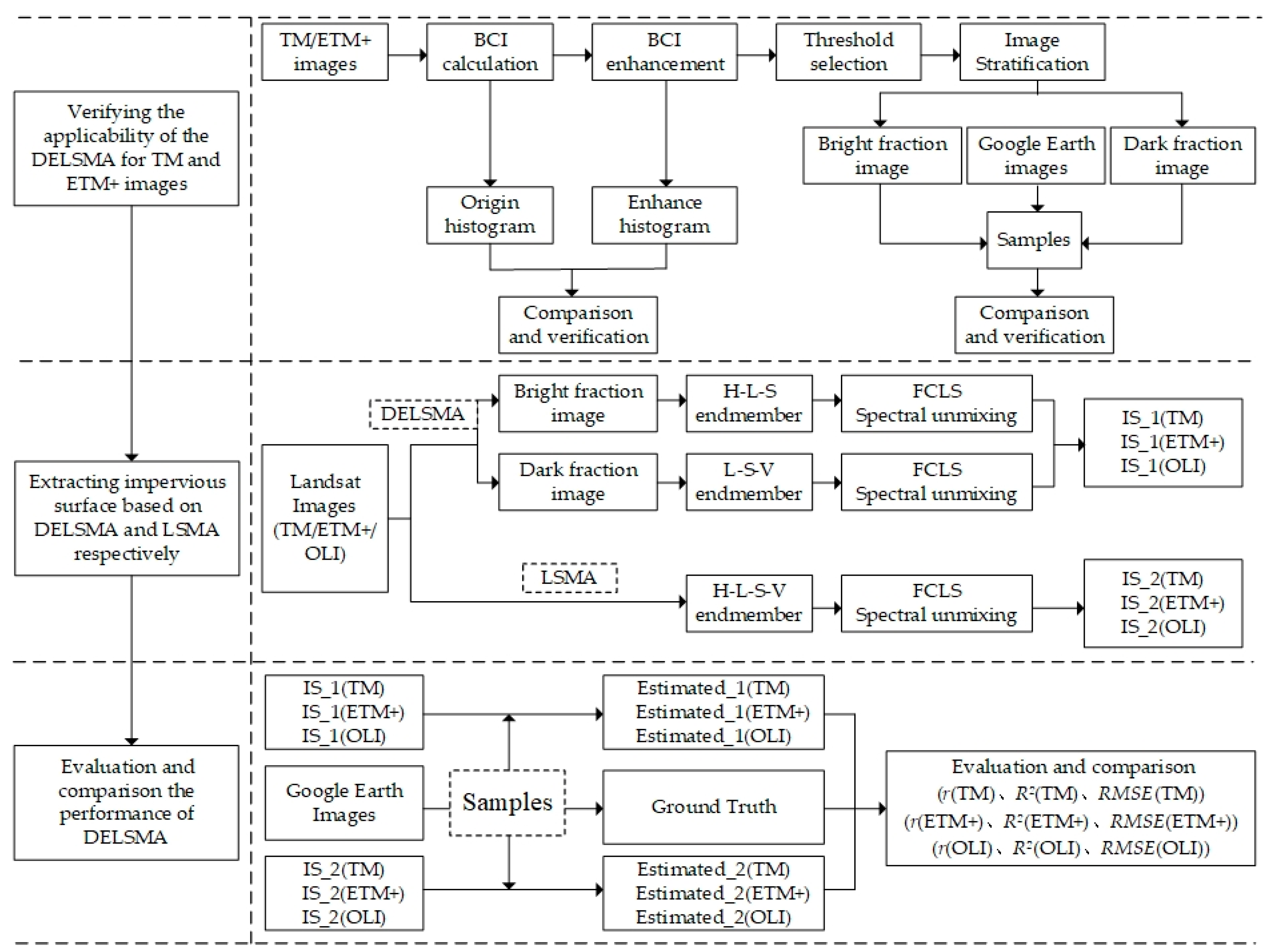
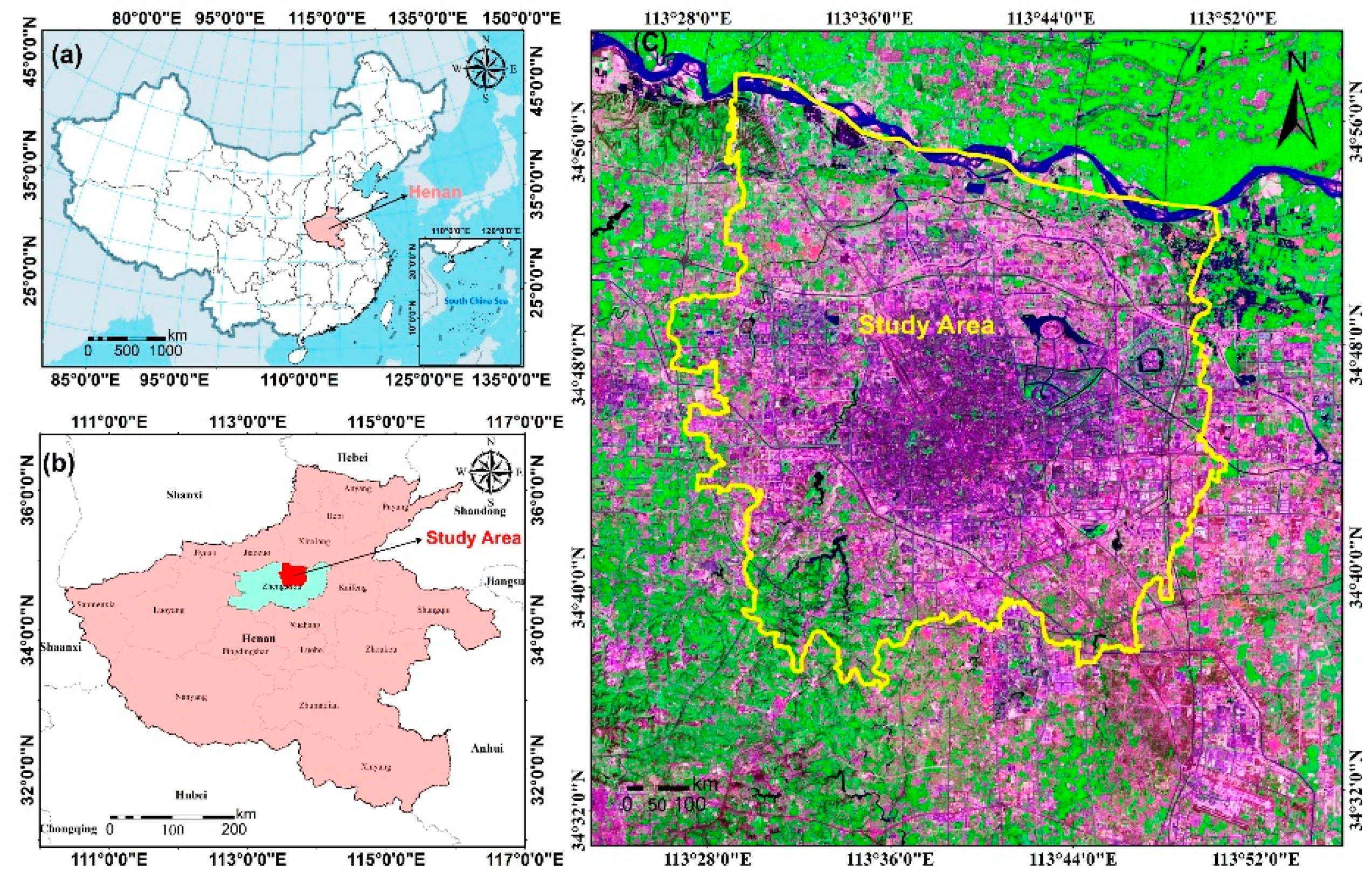
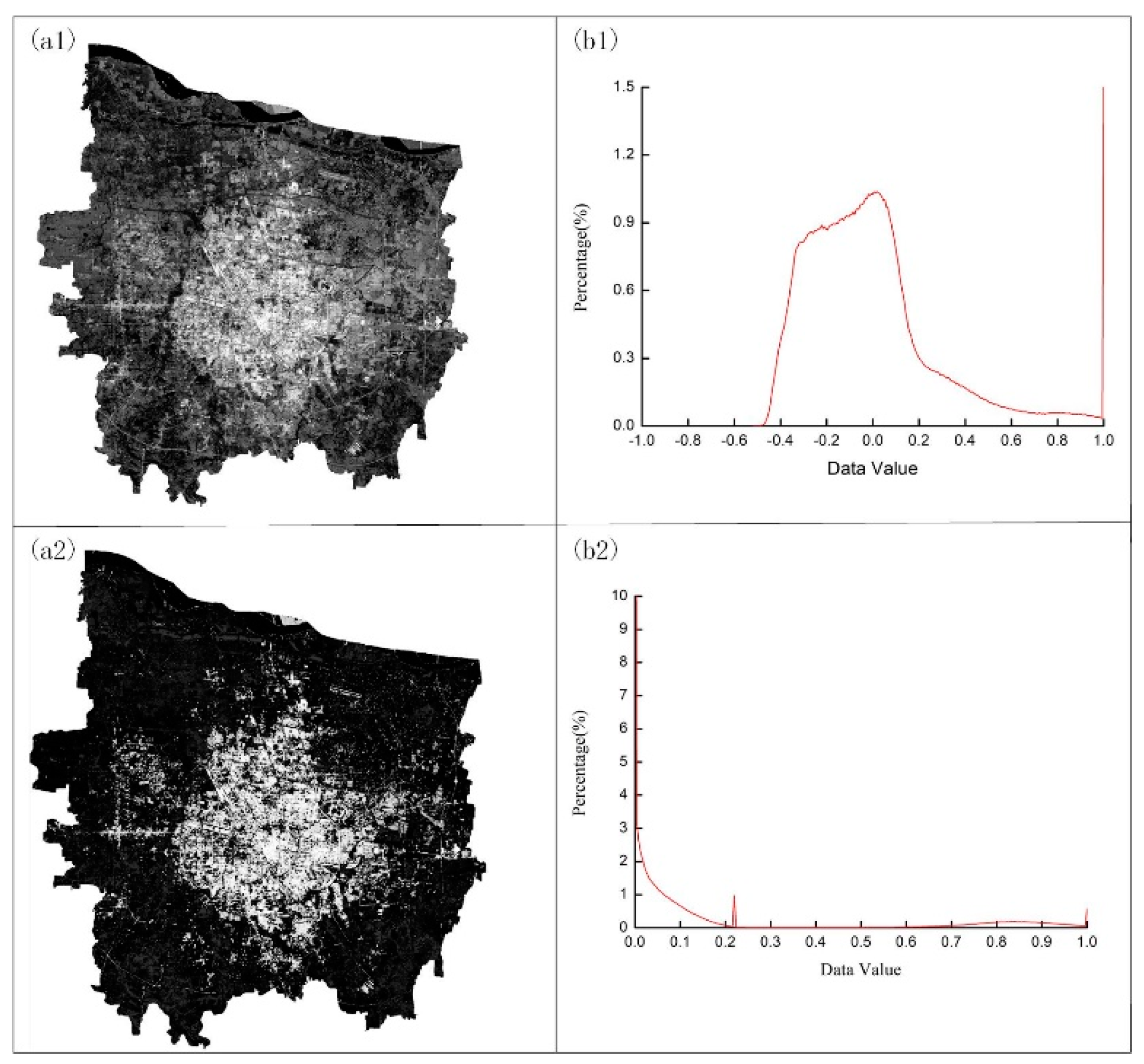
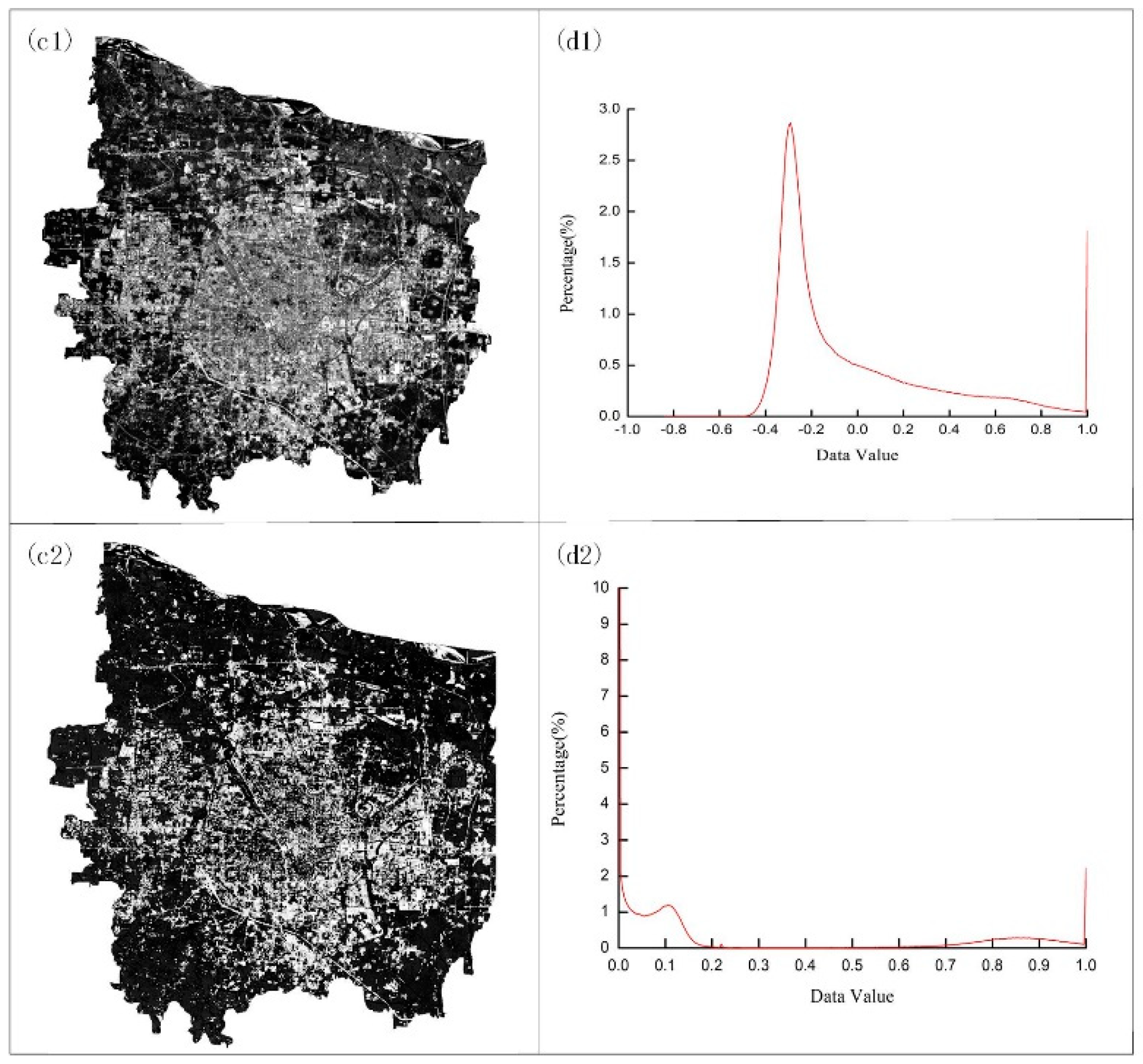

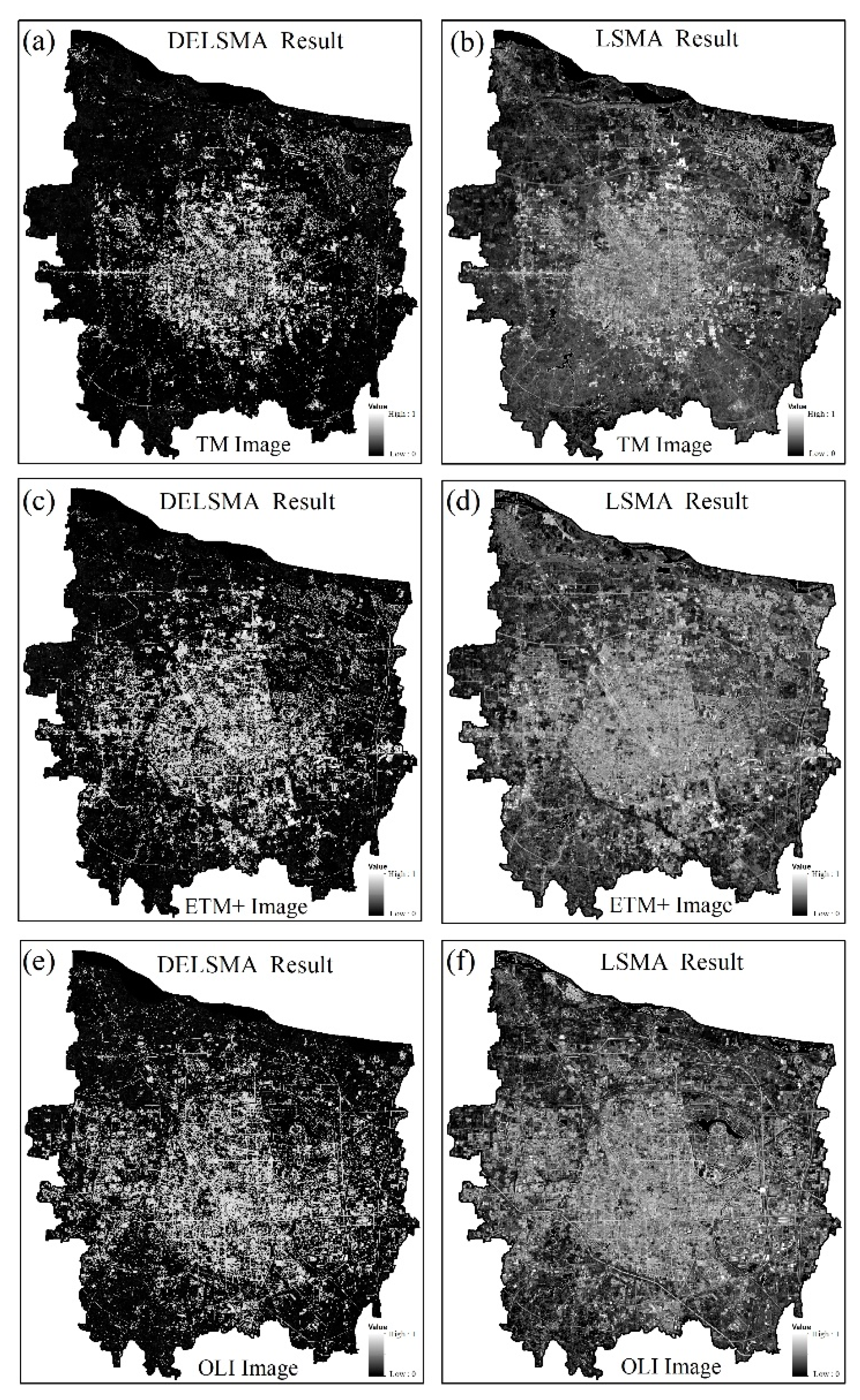
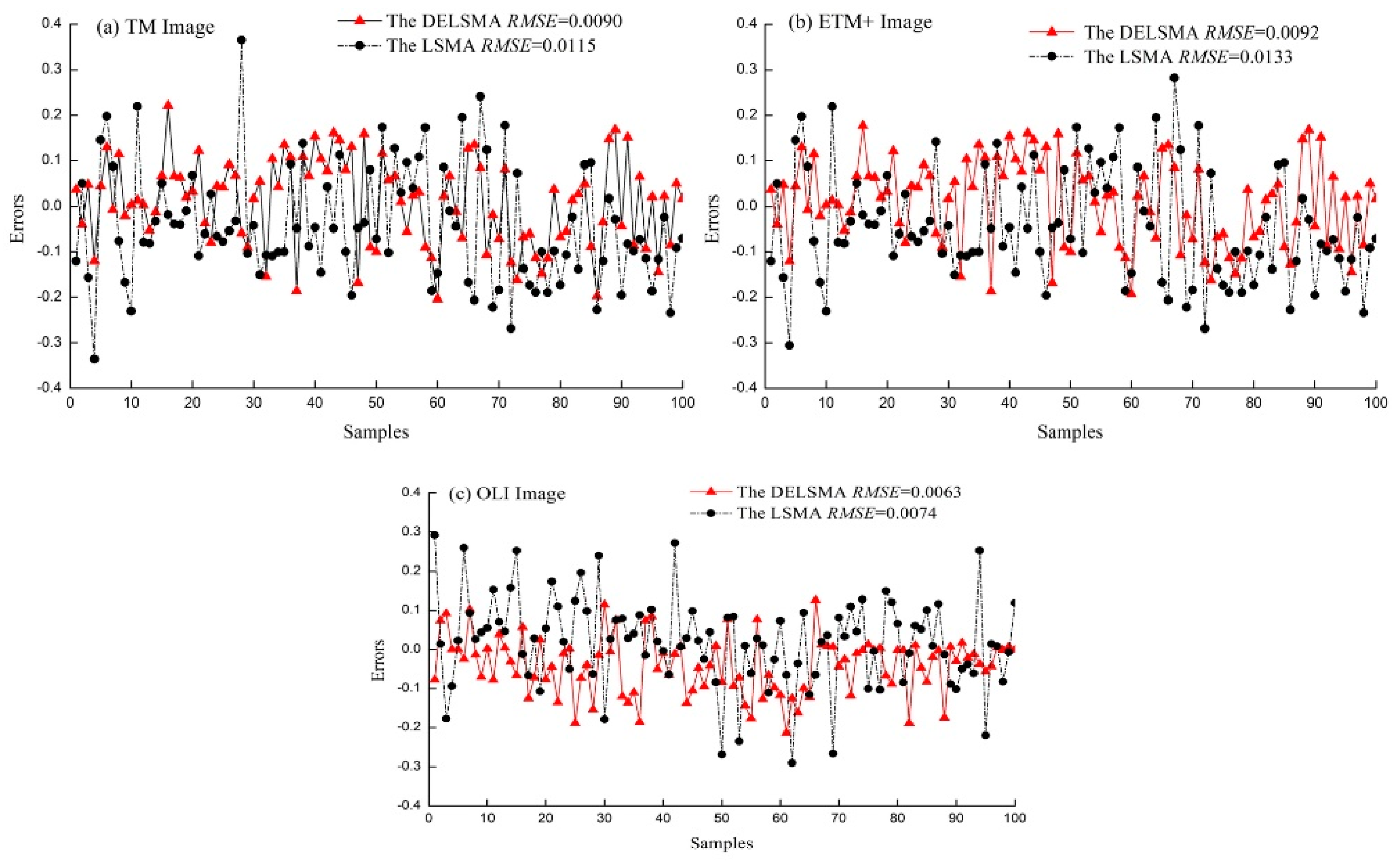
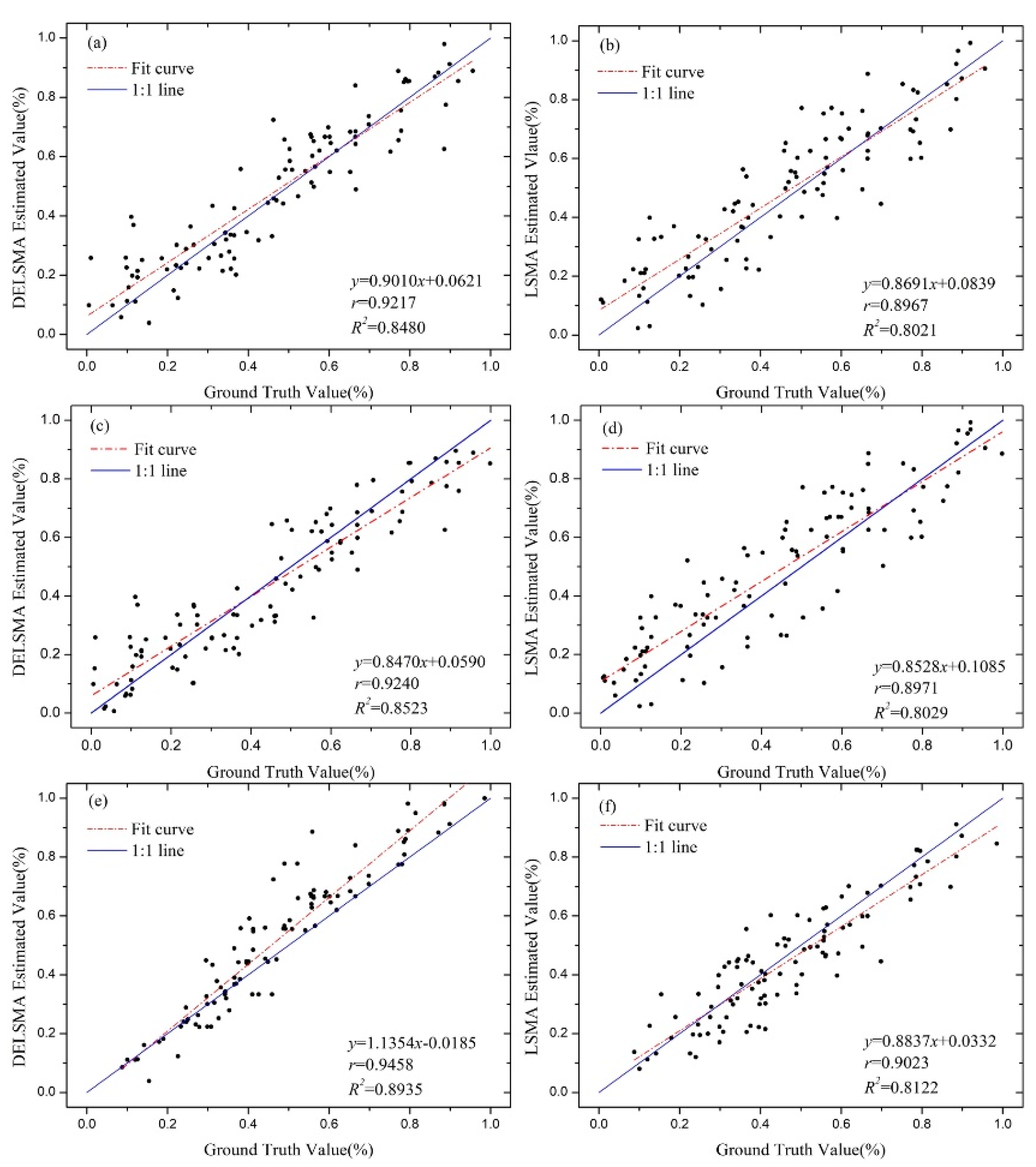
| Applicability | Endmember | Without-Class Spectral Variability | Within-Class Spectral Variability | ||||
|---|---|---|---|---|---|---|---|
| Model | TM | ETM+ | OLI | The Entire Image | Sub-region | ||
| SASMA | Unknow | √ | Unknow | √ | × | √ | × |
| PKSMA | √ | Unknow | Unknow | √ | × | √ | × |
| S-R-LSMA | √ | Unknow | Unknow | √ | × | √ | × |
| SP-SSMA | √ | Unknow | Unknow | × | √ | √ | √ |
| DELSMA | Unknow | Unknow | √ | × | √ | √ | √ |
| Landsat8 | |||||
| Sensor | Band No. | Band | Wavelength | Spatial Resolution/m | Radiometric Resolution/bit |
| OLI | 1 | Dark-Blue | 0.43–0.45 | 30 | 12 |
| 2 | Blue | 0.45–0.51 | 30 | 12 | |
| 3 | Green | 0.53–0.59 | 30 | 12 | |
| 4 | Red | 0.64–0.67 | 30 | 12 | |
| 5 | Near-Infrared | 0.85–0.88 | 30 | 12 | |
| 6 | SWIR 1 | 1.57–1.65 | 30 | 12 | |
| 7 | SWIR 2 | 2.11–2.29 | 30 | 12 | |
| 8 | Panchromatic | 0.50–0.68 | 15 | 12 | |
| 9 | Cirrus | 1.36–1.38 | 30 | 12 | |
| TIRS | 10 | TIRS 1 | 10.6–11.19 | ||
| 11 | TIRS 2 | 11.5–12.51 | |||
| Landsat5/7 | |||||
| Sensor | Band No. | Band | Wavelength | Spatial Resolution/m | Radiometric Resolution/bit |
| TM/ETM+ | 1 | Blue | 0.45–0.52 | 30 | 8 |
| 2 | Green | 0.52–0.60 | 30 | 8 | |
| 3 | Red | 0.63–0.69 | 30 | 8 | |
| 4 | Near-Infrared | 0.77–0.90 | 30 | 8 | |
| 5 | Near-Infrared | 1.55–1.75 | 30 | 8 | |
| 7 | Mid-Infrared | 2.08–2.35 | 30 | 8 | |
| 8 | Panchromatic (Only Landsat7) | 0.52–0.90 | 15 | 8 | |
| 6 | Thermal | 10.40–12.50 | Landsat7(60) Landsat5(120) | 8 | |
| S.no | Date | Sensor | Path/Row |
|---|---|---|---|
| 1 | 2006/6/17 | Landsat 5 TM | 124/36 |
| 2 | 2011/7/25 | Landsat 7 ETM+ | 124/36 |
| 3 | 2017/4/28 | Landsat 8 OLI | 124/36 |
© 2019 by the authors. Licensee MDPI, Basel, Switzerland. This article is an open access article distributed under the terms and conditions of the Creative Commons Attribution (CC BY) license (http://creativecommons.org/licenses/by/4.0/).
Share and Cite
Huang, X.; Liu, W.; Han, Y.; Wang, C.; Wang, H.; Hu, S. Performance Evaluation and Comparison of Modified Spectral Mixture Analysis Method for Different Images of Landsat Series Satellites. Sustainability 2019, 11, 6227. https://doi.org/10.3390/su11226227
Huang X, Liu W, Han Y, Wang C, Wang H, Hu S. Performance Evaluation and Comparison of Modified Spectral Mixture Analysis Method for Different Images of Landsat Series Satellites. Sustainability. 2019; 11(22):6227. https://doi.org/10.3390/su11226227
Chicago/Turabian StyleHuang, Xiaodong, Wenkai Liu, Yuping Han, Chunying Wang, Han Wang, and Sai Hu. 2019. "Performance Evaluation and Comparison of Modified Spectral Mixture Analysis Method for Different Images of Landsat Series Satellites" Sustainability 11, no. 22: 6227. https://doi.org/10.3390/su11226227
APA StyleHuang, X., Liu, W., Han, Y., Wang, C., Wang, H., & Hu, S. (2019). Performance Evaluation and Comparison of Modified Spectral Mixture Analysis Method for Different Images of Landsat Series Satellites. Sustainability, 11(22), 6227. https://doi.org/10.3390/su11226227





